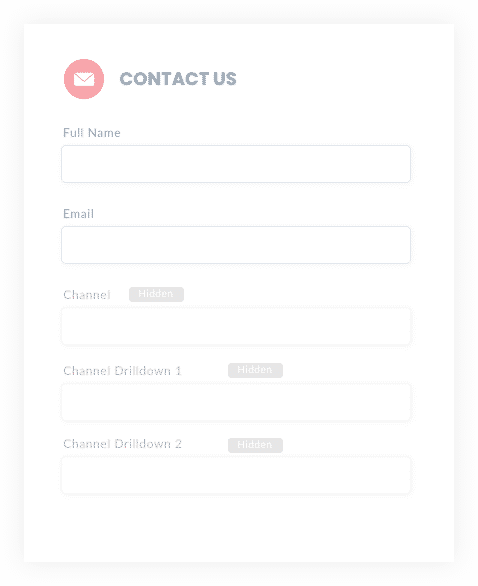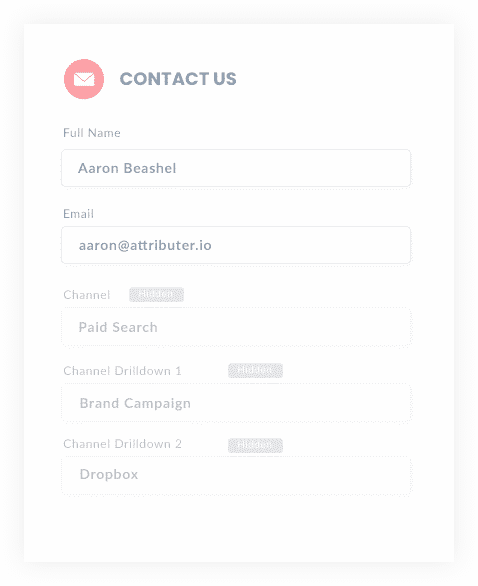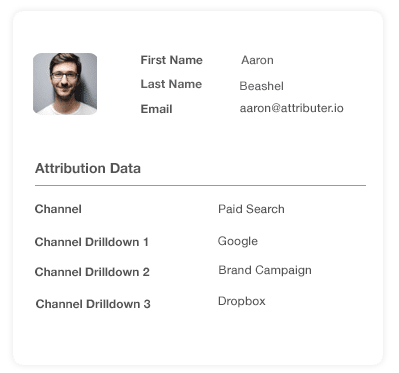4 simple steps to capture UTM parameters in your ExpressionEngine website
Learn how to capture UTM parameters in your ExpressionEngine website and send them through to your CRM and other tools

Do you know which marketing channels & campaigns are generating customers & revenue for your business? If not, how do you know what to do to grow?
By tracking the source of all your leads in your CRM you'll be able to run reports that show you the ROI of your various marketing efforts and inform you which one's to double down on.
In this article, we'll show you how to capture UTM parameters in your ExpressionEngine website & forms and send them through to your CRM and other tools.
4 steps for capturing UTM parameters in your ExpressionEngine website
Using Attributer to capture UTM parameters in your ExpressionEngine website is easy. Here's how to do it in 4 easy steps:
1. Add UTM variables to your ads

The first step to tracking UTM parameters in your CRM is by adding them to your ads and campaigns.
This process will help enable Attributer to recognize where your website visitors have come from and pass them into your CRM for reporting.
Add UTM parameters to any ads and campaigns you are running. It could be on social media platforms like Instagram, LinkedIn, Facebook, and Twitter or on search engines like Google and Bing.
You can also use them on bespoke campaigns such as advertisements you may have in a trade publication, and email campaigns.
2. Add hidden fields to your forms

By adding hidden fields (I.e. fields that exist on the form but are invisible to end-users) to your lead capture forms, Attributer can write the UTM parameters into them when a visitor submits the form.
Depending on which form-building extension you are using, you should be able to simply drag and drop a 'Hidden Field' field type into your form or make an existing field hidden by selecting the 'Hidden' tick box in the field's properties.
The 6 hidden fields you need to add include:
- Channel
- Channel Drilldown 1
- Channel Drilldown 2
- Channel Drilldown 3
- Landing Page
- Landing Page Group
3. Attributer automatically completes the hidden fields with UTM parameters

From here, Attributer will capture the UTM parameters of your website visitors and write them into the hidden fields in your forms.
To illustrate how this works, imagine you work for Salesforce and you're running ads in Google.
A person searches Google for "best CRM system' and finds a Salesforce ad in the paid resulst. The user then clicks the ads and fills out a form on the Salesforce website to request ademo.
In this case, Attributer might write the following tracking information into the hidden fields on the form (depending on what UTM parameters Salesforce uses):
- Channel = Paid Search
- Channel Drilldown 1 = Google
- Channel Drilldown 2 = Best CRM Campaign
- Channel Drilldown 3 = Free Demo Ad
On top of this, Attributer would also include the landing page information, which looks akin to this:
- Landing Page = www.salesforce.com/comparison/best-crm-software
- Landing Page Group = /comparison
4. UTM parameters are passed into your CRM

After the user has submitted the form, the UTM parameters that Attributer wrote into the hidden files are captured alongside the lead's name, email, company, etc.
With ExpressionEngine's integrations, this data can be sent to your CRM, email marketing tool, and more. Or tools like Zapier can be employed to send it to Google Sheets and other destinations.
Finally, you can run reports that answer key marketing questions such as:
- How many leads have we generated from our Facebook campaigns?
- How many customers have we got from our Google Ads?
- How much revenue has been generated from our LinkedIn Ads?
What is Attributer?
Now you know how Attributer help marketers capture UTM parameters on ExpressionEngine websites, you might be wondering what exactly Attributer is and how it works.
Attributer is a piece of code you place on your website that looks at several pieces of technical information (UTM parameters, referrer, device, etc) to determine how a visitor arrived at your website.
It then sorts each visitor into a variety of Channels, such as Paid Search, Organic Search, Paid Social, etc. and stores the data in a cookie in the visitor’s browser.
After the visitor has filled out a form on your ExpressionEngine website, Attributer writes their UTM parameters and other marketing attribution information into hidden fields on the form.
Lastly, after the user has submitted the form successfully, the UTM parameters and other marketing data are passed to your CRM and other tools alongside the lead's name, email, company, phone number, etc.
Ultimately, it enables you to run reports that show you exactly what marketing channels and campaigns are driving your customers & revenue.
Attributer was originally created by a B2B marketing consultant who needed a tool to identify which channels were actually turning visitors into leads and customers.
Today, Attributer is used on hundreds of websites and provides Attribution information for over 3 million visitors to those sites every month.
Why using Attributer is better than capturing raw UTM parameters
There are other tools and methods for capturing UTM parameters on your ExpressionEngine website, so why use Attributer?
Here's why it's so much better:
1. Captures all traffic
Attributer captures all sources of traffic to your ExpressionEngine website and passes it through to your CRM and other tools.
This not only includes paid channels you've been able to add UTM parameters (like Paid Search and Paid Social), but it also includes channels where UTM parameters aren't present (Like Organic Social, Organic Search, Direct, Referral, etc.)
So when you're running reports in your CRM to see where your leads & customers are coming from, you'll be able to see the source of all your leads and not just the ones that have come from your paid campaigns.
With this, you'd gain better insight into what’s working and what isn't and can make better decisions on how to grow.
2. Remembers the data
Most, if not all, the other tools & methods for capturing UTM parameters require the UTM parameter to actually be present on the page where the visitor submits your form.
This is a huge constraint because there might be a difference in the pages your form is completed and the page they landed on from your ad.
To help illustrate, let's imagine a lead clicks one of your Google Ads and is directed to a landing page you've made for that campaign.
Convinced your product is great, he clicks on the 'Get A Quote' button and is taken to a completely different page to complete your quote request form.
This would mean the page the lead submits your form on is different to their original landing page, and therefore the UTM parameters are lost.
Fortunately, Attributer works differently. It saves the UTM parameters in a cookie in the user's browser, meaning they can be captured regardless of what page a lead completes a form on.
3. Provides cleaner data
One of the major problems with the use of other tools that capture raw UTM parameters is that you can end up with messy data that makes it difficult to run accurate reports.
As an example, imagine some of your Twitter campaigns are tagged with UTM_Source=Twitter.com (capital T), others with UTM_Source=twitter (lowercase, no domain), and others with UTM_Source=tw.
When you pass this data into your CRM and try to use it to see how many leads your Twitter campaigns have brought you, you'll get three different sources that you would then have to stitch together.
With Attributer, you don't have to deal with this though because it takes the possibility of capitalization and other inconsistencies into account, and will ascribe leads to the right channel regardless.
4. Captures landing page data as well
Do you wish you could run a report that shows how many customers came from the blog posts you spent hours writing?
Attributer can help here too. Not only does it capture UTM parameters but it also records the landing page (I.e. attributer.io/blog/capture-utm-parameters) and landing page category (I.e. /blog) of each of your leads.
With this data, you will be able to see how certain sections of your website are performing (I.e. your blog) in terms of generating leads, customers & revenue.
And because it captures both the landing page and landing page group, you'll be able to look at how groups of content are performing (I.e. your blog) as well as how individual pages or pieces of content are performing (I.e. individual blog posts).
Wrap up
Attributer does more than just capture UTM parameters.
It does a lot behind the scenes to ensure you have better data to analyze and better insights you can use to grow your business.
Interested in seeing how Attributer can work for you? Get a 14-day free trial to find out if it is right for your needs.
Get Started For Free
Start your 14-day free trial of Attributer today!

About the Author
Aaron Beashel is the founder of Attributer and has over 15 years of experience in marketing & analytics. He is a recognized expert in the subject and has written articles for leading websites such as Hubspot, Zapier, Search Engine Journal, Buffer, Unbounce & more. Learn more about Aaron here.
